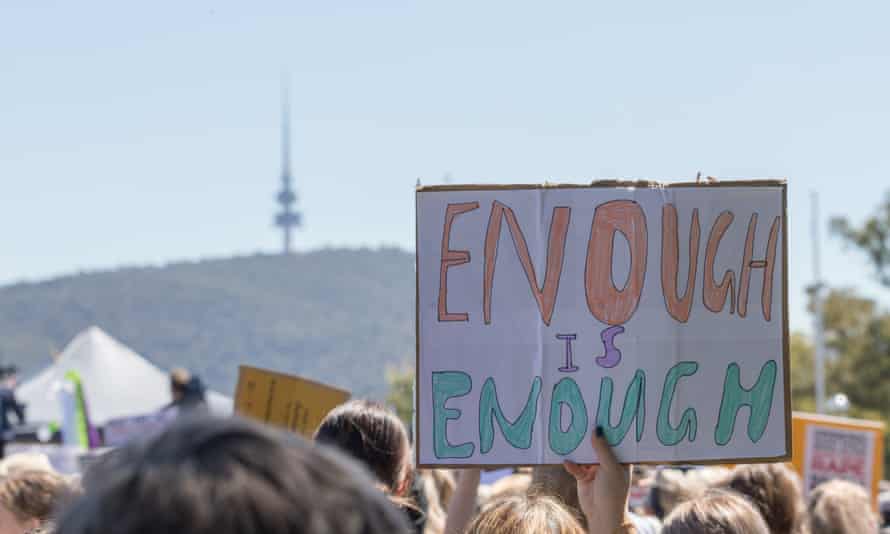Extract from The Guardian
The refusal to fix Australia’s employment, retirement and care systems is a key reason why so many women are unable to leave the men causing them harm
Last modified on Wed 17 Mar 2021 13.09 AEDT
The anger rightfully displayed around Australia on Monday comes after more than a century of failure by the men who dominate Australian politics to address the problems that dominate the lives of Australian women.
Women are far more likely to experience violence at the hands of men than the other way around. That includes sexual violence, physical violence and controlling psychological behaviour. Policies to make it easier to report abuse, escape abuse, and adequately punish perpetrators of abuse would disproportionately help women. Maybe that is why so many powerful men have been so apathetic about implementing them.
While men’s violence against women is driving this latest round of protests, men’s refusal to fix Australia’s employment, retirement and care systems is a key reason why so many women are unable to leave the men who cause them so much harm.
Women earn 13.4% less than men – an average of $242.90 a week. In 2020 new female graduates were earning on average $6,900 a year less than their male colleagues. If only there was something men in power could do about the amount of money they pay to their female employees.
Over the past 30 years, the casualisation of work in Australia means that 35.7% of the workforce have no sick leave or holiday leave and, you guessed it, a higher proportion of women cannot access these benefits. Women do more care for kids and elderly parents than men, they spend more time around sick people than men, they do more holiday care for school-aged kids than men, and they are less likely to have sick leave and holiday leave than men. How good is Australia!
And then, there is childcare. While other rich countries such as Sweden, Norway and Denmark provide high-quality childcare for free or at very low prices, Australia has embraced a “user pays” approach. If Australia had the same female participation rate as the Nordic countries, then 380,000 additional women would be employed, which is worth an extra $48bn per year to GDP.
But fear not. According to the education minister, Alan Tudge, childcare “only” costs around $5 an hour which might sound cheap to a bloke who gets paid $291 a day in travel allowance whenever he is in Canberra – but it adds up fast for a woman with three kids in care for eight hours a day, three days a week ($360 a week).
It gets worse. Because women earn less than men and take more time out of the workforce to raise kids than men, women contribute far less in compulsory superannuation than men. And because the $41bn a year in taxpayer contributions to our superannuation accounts are proportionate to how much money we have saved up, guess what? Blokes get far more of the taxpayer support for so-called “self-funded retirement” than women.
Are you ready to get really angry? After years of starving domestic violence shelters of funding and refusing to make domestic violence leave compulsory in all enterprise agreements, the Morrison government has decided to let women fleeing violent partners “self-fund” their escape via early access to their superannuation.
Australia is not only one of the oldest continuous democracies in the world, but also one of the richest countries in the world. We have solved many problems in the 120 years since federation but there are many that we have been too busy, or too bored, to address. Since the last election, the commonwealth government alone has spent more than $1tn, including more than $200bn on stimulus programs, $500m extending the war memorial and $102m on sports grants.
But a lack of interest, rather than a lack of money, means that we are yet to address the gender pay gap, the gender retirement income gap, or the crisis in our aged care system which, you guessed it, affects more women than men.
The commonwealth government can afford to fix any problem it wants. I know this because it gave me a nice big tax cut and, from July 2024, it’s planning to spend almost $18bn per year on an even bigger tax cut for high-income earners. I don’t want it, I don’t need it, and I wish that the government would instead spend more money solving the most pressing problems in Australia that affect majority groups like women, and minority groups including Indigenous Australians.
It is not complicated, and if other countries can do it then there is no reason we cannot. But if Australians keep electing governments full of blokes promising to give tax cuts to other blokes, then I fear that it will not just be the anger we saw on Monday that grows further, but the gap between the income of men and women.

No comments:
Post a Comment